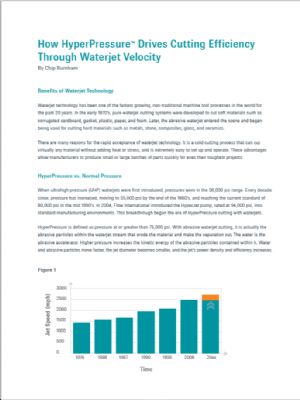 Cutting
CuttingHow HyperPressure Drives Cutting Efficiency Through Waterjet Velocity
 LOG IN TO DOWNLOAD WHITE PAPER
LOG IN TO DOWNLOAD WHITE PAPER
Benefits of Waterjet Technology
Waterjet technology has been one of the fastest growing, non-traditional machine tool processes in the world for the past 20 years. In the early 1970’s, pure waterjet cutting systems were developed to cut soft materials such as corrugated cardboard, gasket, plastic, paper, and foam. Later, the abrasive waterjet entered the scene and began being used for cutting hard materials such as metals, stone, composites, glass, and ceramics.
There are many reasons for the rapid acceptance of waterjet technology. It is a cold-cutting process that can cut virtually any material without adding heat or stress, and is extremely easy to set up and operate. These advantages allow manufacturers to produce small or large batches of parts quickly for even their toughest projects.
HyperPressure vs. Normal Pressure
When ultrahigh-pressure (UHP) waterjets were first introduced, pressures were in the 36,000 psi range. Every decade since, pressure has increased, moving to 55,000 psi by the end of the 1980’s, and reaching the current standard of 60,000 psi in the mid 1990’s. In 2004, Flow International introduced the HyperJet pump, rated at 94,000 psi, into standard manufacturing environments. This breakthrough began the era of HyperPressure cutting with waterjets.
HyperPressure is defined as pressure at or greater than 75,000 psi. With abrasive waterjet cutting, it is actually the abrasive particles within the waterjet stream that erode the material and make the separation cut. The water is the abrasive accelerator. Higher pressure increases the kinetic energy of the abrasive particles contained within it. Water and abrasive particles move faster, the jet diameter becomes smaller, and the jet’s power density and efficiency increases.
Flow International Corp.





Comments
Must be logged in to post a comment. Sign in or Create an Account
There are no comments posted.